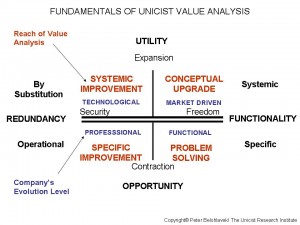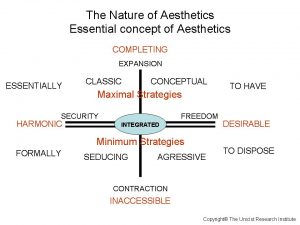 The Unicist Value Analysis has been developed to reduce costs and increase quality and productivity of processes that behave as adaptive systems. This method is included in all the Business Objects that deal with costs, quality and productivity.
The Unicist Value Analysis has been developed to reduce costs and increase quality and productivity of processes that behave as adaptive systems. This method is included in all the Business Objects that deal with costs, quality and productivity.
Value analysis began at General Electric Co. during World War II. It was developed by Lawrence Miles, Jerry Leftow, and Harry Erlicher at G.E. It was designed to deal with systemic problems.
Processes become complex when soft variables participate in them. Processes behave as adaptive systems when human components participate and the “traditional” value analysis is dysfunctional.
As soon as causes-effect relations cannot be considered as valid because there are bi-univocal cause-effect relations a different technique needs to be applied.
The Unicist Value Analysis was developed in 1981-82. The first applications were at: Citibank, Renault, Bayer and BASF. It is a method that considers the technical analytical aspects of process and the fundamentals of adaptive systems’ processes. See graph.
The fundamentals of this method are:
For its maximal strategy:
-Utility
-Systemic Functionality
-Redundancy by substitution
For its minimum strategy:
-Opportunity (Taxonomic)
-Specific functionality
-Operational redundancy
It is necessary to diagnose first what kind of a process one is dealing with.
The evolution level of a company defines the reach of the application of value analysis.
You can access more information on unicist continuous improvement at the Unicist Business Search Engine.
Request more information: n.i.brown@unicist.org
Peter Belohlavek
NOTE: The Unicist Research Institute is the major research organization in the world in its specialty based on more than 3,000 researches in complexity sciences applied to individual, institutional and social evolution.
 Listening to the lecture of John Lilly, CEO of Mozilla, you will access the core fundamental of Mozilla’s success.
Listening to the lecture of John Lilly, CEO of Mozilla, you will access the core fundamental of Mozilla’s success.






















